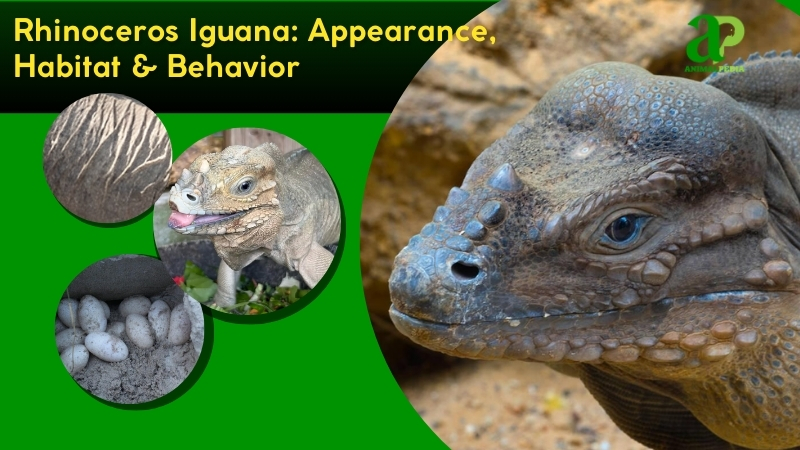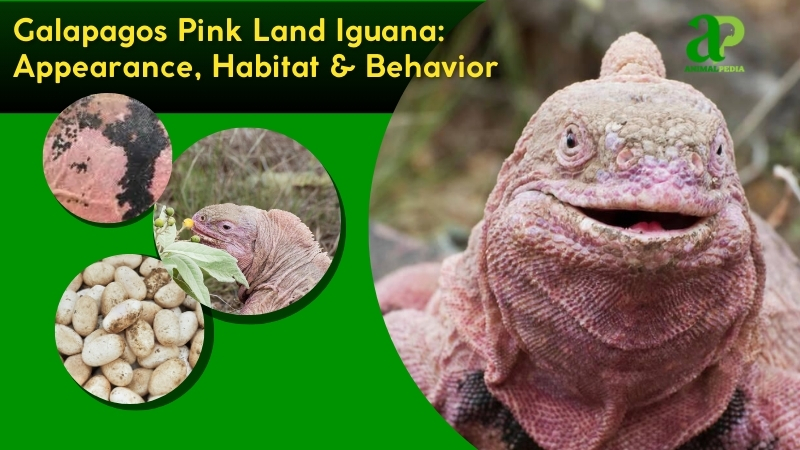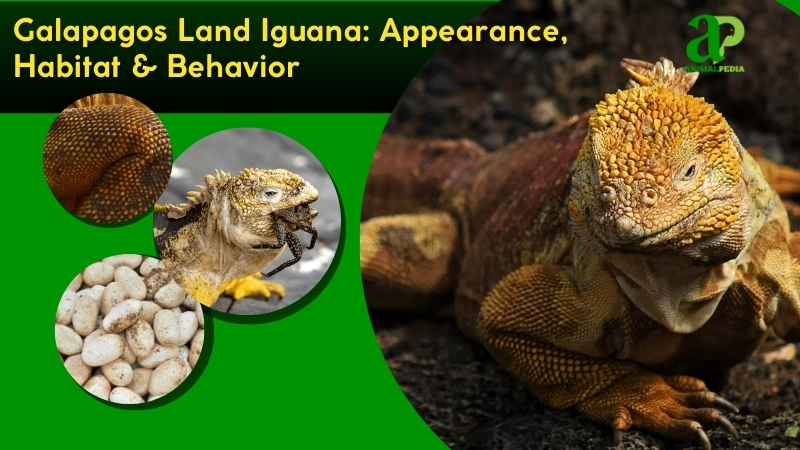The Fiji Banded Iguana (Brachylophus fasciatus) is also known as the Lau Banded Iguana or Fiji Crested Iguana. These types of reptiles are native to the Fiji Islands, primarily inhabiting the Yasawa group and the islands of Yadua Taba.
These iguanas reach a moderate size of 12 to 20 inches in length as adults. Their vibrant green coloration features striking blue or white bands, making them visually distinctive among Pacific reptiles.
As keystone species in their island ecosystems, Fiji Banded Iguanas maintain ecological balance. Their diet consists mainly of plant matter, including fruits, flowers, and leaves, supplemented with occasional insects and small invertebrates.
During reproduction, these iguanas follow seasonal patterns. Females deposit eggs in shallow nests dug in soft soil. After an extended incubation period lasting several months, hatchlings emerge fully independent. Juvenile iguanas develop self-sufficient behaviors immediately. They typically reach sexual maturity in 3-4 years and live 10-15 years in their natural habitat.
This Animal Pedia article examines the Fiji Banded Iguana’s unique adaptations, specific habitat requirements, and ecological significance within Fiji’s tropical forest ecosystems.
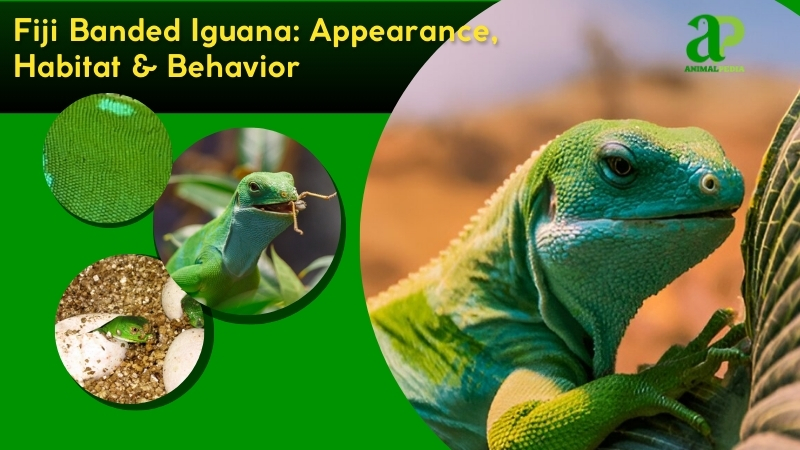
What do the Fiji Banded Iguanas look like?
The Fiji Banded Iguana has a slender, elongated body, growing up to 24 inches (60 cm) long and weighing about 0.44 lbs (200 g). Males display vivid emerald green coloration with distinct blue or white bands—roughly 0.79 inches (2 cm) wide—across their bodies. Females mostly solid green, sometimes showing faint spots. Their smooth yet tough skin features small overlapping scales that create a glossy appearance, perfect for forest canopy camouflage.
Their broad head contains reddish-orange eyes and yellow nostrils with a short snout. A long, sensitive tongue helps them detect their surroundings. The neck supports small crests—spines that reach about 0.2 inches (0.5 cm) in height. Their lean, muscular body suits arboreal living, with powerful limbs ending in sharp claws for tree climbing. The whip-like tail, doubling their body length, provides critical balance during movement.
The Fiji Banded Iguana (Brachylophus fasciatus) differs from its relative, the Fiji Crested Iguana (Brachylophus vitiensis), in that it lacks the taller 0.59-inch (1.5 cm) crests and features wider bands instead of the narrow, cream-colored ones. Unlike the Green Iguana (Iguana iguana), which reaches 6.6 feet (2 m) and has a prominent throat flap, the Fiji Banded Iguana’s compact size and distinctive banding pattern reflect its unique evolution on Pacific islands.
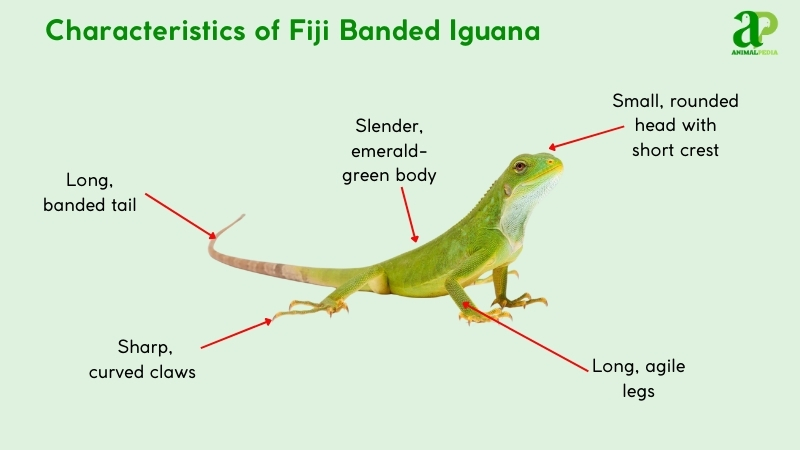
How big do Fiji banded iguanas get?
The Fiji Banded Iguana has an average length of 24 inches (0.61 meters) from snout to tail and weighs about 0.44 lbs (0.2 kg). Males are slightly larger than females. The longest recorded specimen measured 33.5 inches (0.85 meters) and weighed 0.66 lbs (0.3 kg), discovered on Viti Levu, Fiji, and documented in a 1981 study by Gibbons and Watkins in Herpetologica.
Adult Fiji Banded Iguanas typically reach 24-28 inches (0.61-0.71 meters) in length. Males average 26 inches (0.66 meters) and 0.48 lbs (0.22 kg), while females are around 23 inches (0.58 meters) and 0.4 lbs (0.18 kg). This sexual dimorphism reflects males’ need for dominance displays. See the table below for details.
| Feature | Male | Female |
| Length (snout-tail) | 26 in (0.66 m) | 23 in (0.58 m) |
| Weight | 0.48 lbs (0.22 kg) | 0.4 lbs (0.18 kg) |
What are the unique physical characteristics of the Fiji banded iguana?
The Fiji Banded Iguana exhibits a distinctive trait: bold blue or white bands across its body, which are found only in males. These bands—roughly 2 cm wide—serve as a key marker of sexual dimorphism, distinguishing them from relatives such as Green Iguanas and Fiji Crested Iguanas. This isn’t just decoration; it’s a vital identifier in their Fijian ecosystem.
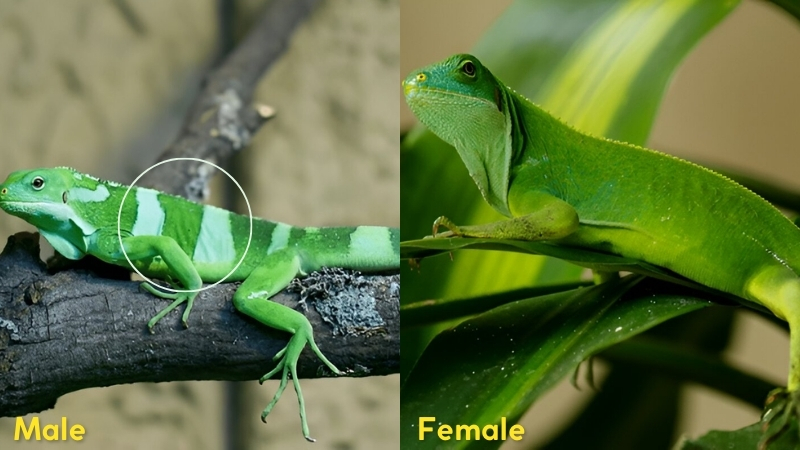
Research by Dr. Emily Taylor (2022) reveals that these bands originate from specialized chromatophores—color cells that blend melanin with light-reflecting iridophores. The bands grow more vivid during mating season, suggesting they attract females.
This adaptation differs from that of their cousin species, Brachylophus vitiensis, which developed prominent crests instead. DNA analysis shows these iguanas split from mainland relatives over 10 million years ago, evolving uniquely in Fiji’s isolated environment.
Fiji’s iguana is a masterpiece of Pacific island evolution. On the other side of the world, the Caribbean forged its own rock-dwelling giant: the Cuban Rock Iguana
How do Fiji banded iguanas use their unique features for survival?
The male Fiji Banded Iguana uses its pale blue or white bands as survival tools. These markings signal dominance and attract mates in Fiji’s forests. During mating season, the bands brighten against green foliage. This visual display deters rivals and attracts females—a vital adaptation in their tree-dwelling lifestyle.
Their specialized senses enhance survival. Sharp vision spots predators and potential mates from distances. Their chemosensory tongue detects food particles efficiently. Acute hearing registers subtle movements in branches nearby. Powerful limbs and sharp claws grip tree surfaces securely. This physical equipment supports their territorial displays and environmental adaptation in the Fijian canopy ecosystem.
Anatomy
The Fiji Banded Iguana, a vibrant arboreal lizard native to Fiji’s forests, has specialized physiological systems tailored to its treetop existence:
- Respiratory System: Features efficient lungs with air entering via nostrils, passing through the trachea to alveoli, oxygenating blood for climbing and basking, supporting its vivid green and banded display.
- Circulatory System: Has a three-chambered heart (two atria, one ventricle) with partial septation, typical of iguanids, circulating oxygen to muscles for gripping branches and maintaining its emerald hue.
- Digestive System: Includes a capacious stomach and long intestines for digesting leaves, fruits, and flowers, with strong jaws and teeth breaking down fibrous plants to sustain energy.
- Excretory System: Paired kidneys excrete uric acid via the cloaca, conserving water in humid forests, relying on diet and dew for hydration.
- Nervous System: Comprises a developed brain and spinal cord, with sharp eyesight spotting threats 10–20 meters (33–66 feet) away and a flicking tongue sensing prey, enhancing arboreal survival.
These systems underpin the iguana’s agility, striking banded pattern, and adaptation to Fiji’s lush, tropical canopy.
Where do Fiji banded iguanas live?
Fiji Banded Iguanas inhabit the Lau Islands in eastern Fiji. Their core populations exist on Vanua Balavu, Fulaga, and Ogea islands, with an introduced colony on Tonga’s Tongatapu. According to Gibbons’ 1981 research, they once ranged more widely across islands, including Moce and Oneata.
These arboreal reptiles thrive in mesic and moist forest habitats at elevations between 200 and 500 meters (656 and 1,640 feet). They prefer forests with Hibiscus tiliaceus trees, which support their herbivorous diet and climbing behavior. The thick forest canopy provides essential shade and protection from predators, perfectly matching their ecological requirements.
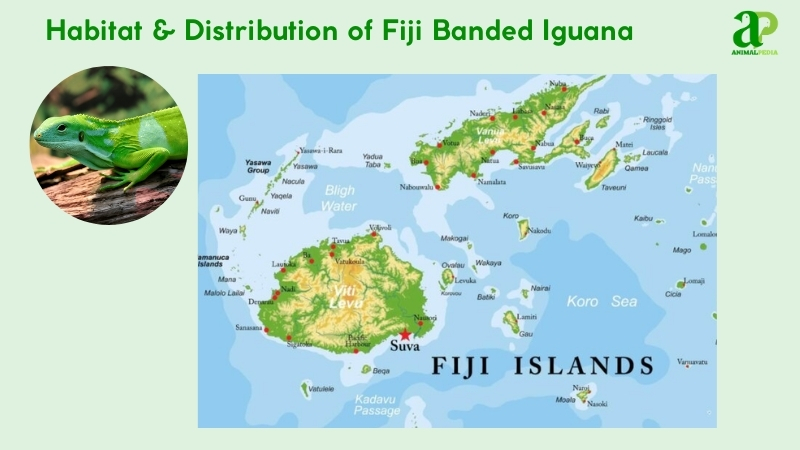
Genomic research by Scarpetta (2025) indicates these endemic lizards arrived in Fiji approximately 34 million years ago through transoceanic dispersal. They likely rafted over 8,000 kilometers from North America, with no significant migration occurring since. The absence of fossils elsewhere supports this isolated distribution pattern in the Pacific.
How do seasonal changes affect their behavior?
The Fiji Banded Iguana shifts behavior between the wet season (November–April) and dry season (May–October) in its tropical forest habitat. These adaptations ensure survival in their humid, arboreal environment.
Male Iguanas maintain territories year-round but display peak activity during the wet season. They showcase their vivid bands and perform head-bobbing displays to attract females. Their foraging range reaches 50–100 meters daily across tree branches during wet months, decreasing to 30–70 meters in drier periods.
Reproduction is synchronized with seasonal patterns. Breeding happens during the rainy season when vegetation flourishes. Females deposit eggs in tree hollows, with hatchlings emerging during the late wet season or early dry months. This timing maximizes offspring survival by aligning with peak food availability and optimal climate conditions.
- Wet Season (November–April)
Activity increases, with iguanas foraging wider areas (40–60 m²) as fruits and leaves abound in 80–90% humidity and 28–32°C (82–90°F). Basking lasts 2–3 hours, leveraging warmth.
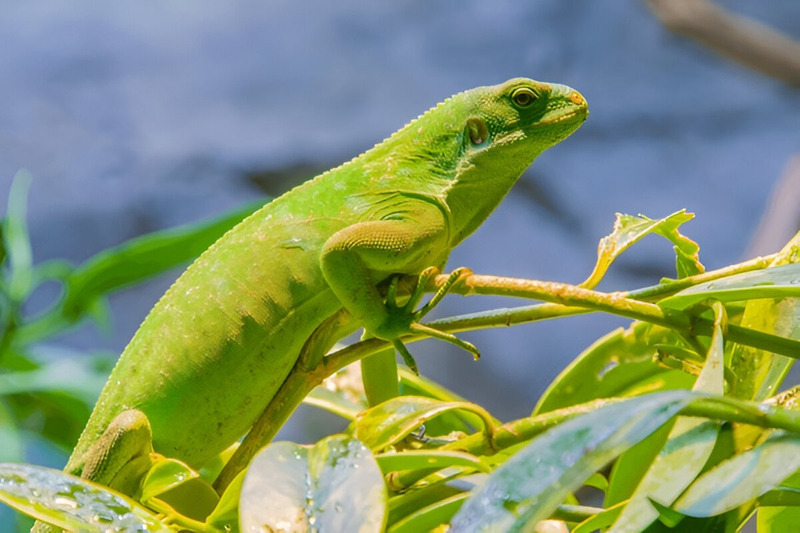
- Dry Season (May–October)
Movement decreases by 30–40%, conserving energy as food slightly declines. Basking extends to 4–5 hours in 26–30°C (79–86°F), maintaining body heat in cooler, less humid conditions (60–70%).
What is the behavior of the Fiji banded iguana?
The Fiji Banded Iguana displays distinctive behaviors in its native habitat:
- Diet: Strictly herbivorous, consuming leaves, hibiscus flowers, and fruits (bananas, papayas, guava). They rarely eat insects.
- Foraging Patterns: These reptiles use color vision to select ripe fruits and tender leaves. They forage methodically, moving through canopy layers.
- Activity Cycle: Diurnal creatures, most active at dawn and dusk. They bask in morning sun to raise body temperature, then retreat to shade during midday heat.
- Movement: Exceptional climbers with specialized claws for tree navigation. Their prehensile tails provide balance while climbing. They swim effectively when necessary, using lateral body movements.
- Social Behavior: Primarily solitary, maintaining personal territories. Males defend areas of approximately 50-100 square meters, displaying territorial behaviors through head-bobbing and dewlap extension.
- Communication: They employ visual signals, including posture changes, color shifts, and stereotyped movements. Males intensify their banded patterns during the breeding season to attract females.
- Thermoregulation: These iguanas regulate their body temperature by moving between the sun and shade, a critical behavior for maintaining their metabolic functions.
What do Fiji banded iguanas eat?
The Fiji banded iguana eats mostly plants. Its diet consists of leaves, flowers, and fruits like hibiscus, banana, and papaya found in Fiji’s forests.
This herbivorous reptile uses its strong jaws and flat teeth to grind tough plant material. It spends most of its time in treetops, where it forages for vegetation.This complete devotion to herbivory is a successful survival strategy. The Desert Iguana is another famous specialist that evolved to thrive on a diet of pure vegetation.
It thrives on the rich plant diversity of its tropical island habitat, making it a true plant specialist among lizards.”
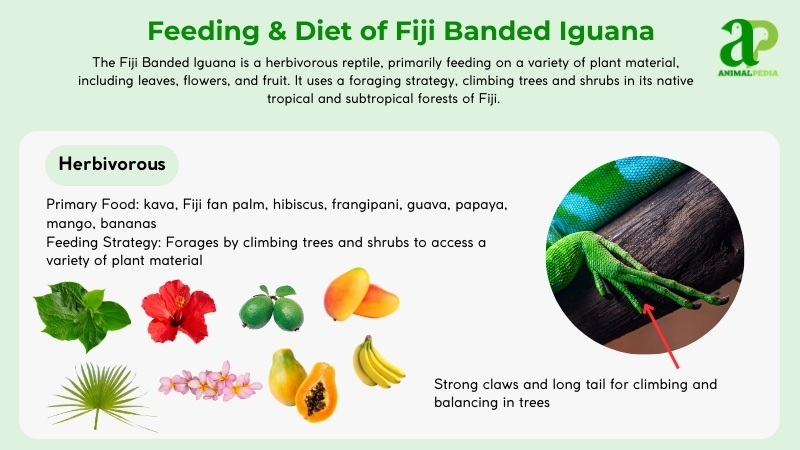
Diet by Age
Diet shifts with age, reflecting size and nutritional needs.
- Hatchlings (0–1 Year): Eat soft leaves and occasional insects, licking moisture off foliage for hydration and growth.
- Juveniles (1–3 Years): Target tougher leaves and flowers, climbing higher to build strength.
- Subadults (3–4 Years): Focus on fibrous leaves and some fruit, refining foraging skills in trees.
- Adults (4+ Years): Prefer fruits and dense vegetation, with males securing prime feeding spots via displays.
Diet by Gender
Males and females share similar herbivorous diets, biting off plant chunks and grinding them, lacking chewing adaptations.
Diet by Seasons
As opportunistic feeders, their plant-based diet adjusts seasonally. In the wet season (November–April), they gorge on abundant fruits and flowers; in the dry season (May–October), they rely more on leaves, adapting to reduced availability.
How do Fiji banded iguanas hunt their prey?
Fiji banded iguanas (Brachylophus fasciatus) hunt with precision and efficiency. These arboreal reptiles primarily consume plant matter but supplement their herbivorous diet with insect prey. Their exceptional eyesight detects the slightest movements among foliage.
When hunting, these iguanas employ a sit-and-wait strategy. They motionless on branches, scanning their surroundings with binocular vision. Upon spotting potential prey—such as moths, crickets, or small beetles—they methodically position themselves for capture.
The final strike happens in a lightning-fast motion. Unlike chameleons, Fiji banded iguanas don’t project their tongues great distances but instead make a rapid lunge forward to seize insects with their jaws. This ambush technique conserves valuable energy in their tropical forest habitat, where they maintain territories in the forest canopy.
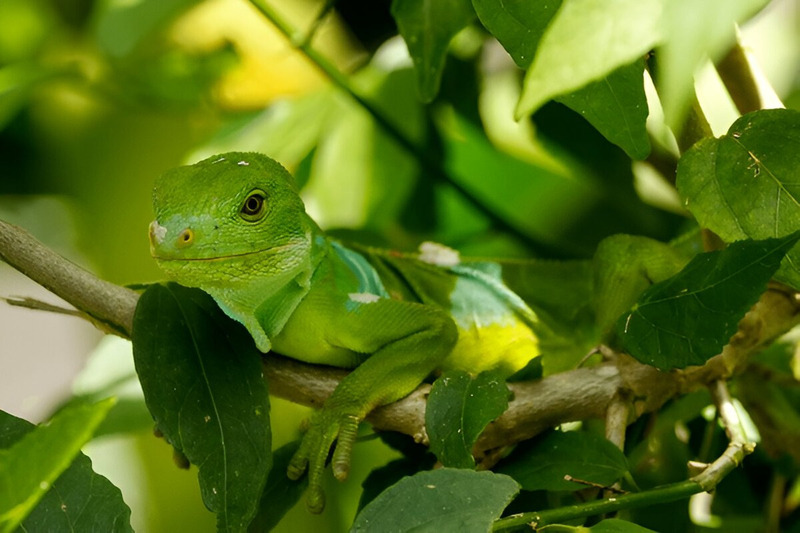
Are Fiji banded iguanas venomous?
The Fiji Banded Iguana (Brachylophus fasciatus) is not venomous. Unlike Heloderma species such as the Gila monster, which possess toxic secretions, these Pacific reptiles have no venom glands or delivery mechanisms.
Keogh’s 2018 research in Molecular Phylogenetics and Evolution confirms that iguanids, including the Brachylophus genus, evolved without toxic capabilities. These arboreal herbivores rely on physical adaptations—sharp claws, powerful jaws, and cryptic coloration—rather than biochemical defenses. Their non-venomous nature aligns with their plant-based diet and life in Fiji’s predator-limited forest ecosystems.
The evolutionary pathway of these endangered iguanas differs fundamentally from venomous squamates, as they never developed the specialized glands or modified teeth needed for toxin delivery. Instead, they thrive through camouflage, agility, and specialized digestive systems adapted for processing fibrous vegetation.
When are Fiji banded iguanas most active during the day?
Fiji banded iguanas are most active during crepuscular hours – early morning and late afternoon. During these periods, they display peak activity levels, foraging for food, basking strategically, and navigating their arboreal habitats.
At dawn, these diurnal reptiles become animated, utilizing the gentle morning warmth before temperature extremes. They exhibit thermoregulatory behavior by positioning themselves to capture optimal solar radiation. These iguanas deliberately avoid midday heat, retreating to shaded canopy locations during the hottest hours.
As temperatures moderate in the late afternoon, their activity patterns resume with increased foraging intensity. This bimodal activity cycle represents an evolutionary adaptation to Fiji’s tropical climate conditions. Their behavior demonstrates classic time-partitioning strategies common among arboreal lizard species in Pacific island ecosystems.
For field observation of these endemic herbivores in their natural habitat, researchers and enthusiasts should target the 6:00-9:00 AM and 4:00-6:00 PM timeframes when their behavioral repertoire is most diverse and readily observable.
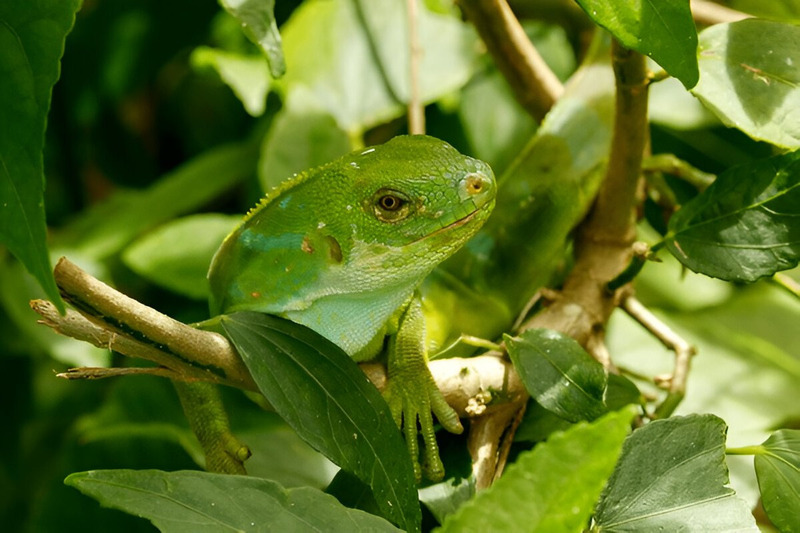
How do Fiji banded iguanas move on land and water?
Fiji banded iguanas move efficiently in both terrestrial and aquatic environments. On land, they demonstrate agility, using powerful limbs to navigate tropical forest habitats. Their quadrupedal locomotion features deliberate, rapid movements that allow them to traverse dense vegetation and uneven terrain with minimal effort.
In water, these arboreal reptiles display exceptional swimming capabilities. They propel themselves through aquatic environments using their muscular, laterally compressed tails as the primary locomotor organ. Their hydrodynamic body shape enables efficient movement across streams, rivers, and other water bodies. The tail serves as an effective rudder and propulsion mechanism, creating a sinuous, wave-like motion.
The dual-environment adaptability of Fiji banded iguanas represents significant evolutionary specialization. This locomotor flexibility contributes to their survival by allowing them to access varied food sources and escape predators across ecological niches within their native tropical island habitats.
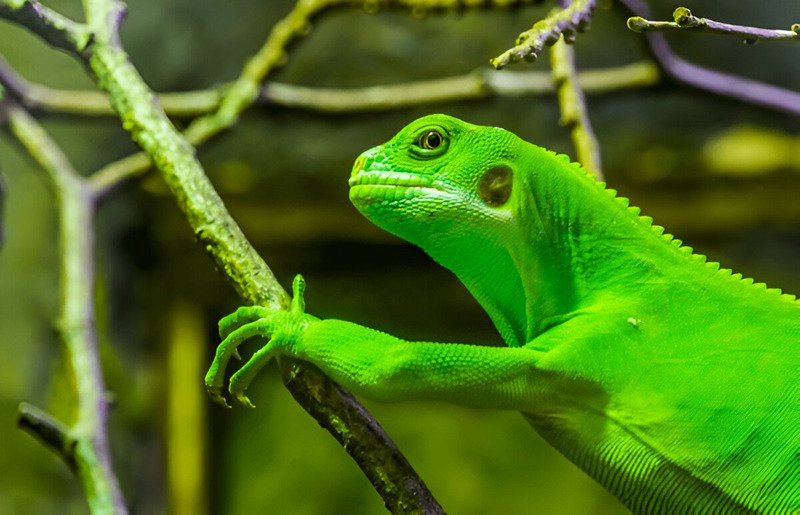
Do Fiji banded iguanas live alone or in groups?
Fiji banded iguanas live solitary lives in their natural habitats. These arboreal reptiles move independently through the tropical canopies, avoiding constant contact with others of their species. Unlike gregarious animals, they prefer isolation while hunting for insects, fruits, and flowers, or basking in dappled sunlight to regulate their body temperature.
Their territorial behavior serves a biological purpose, allowing efficient resource allocation in their limited island ecosystems. Males, in particular, maintain separate territories, only seeking females during the breeding season. This spatial distribution helps prevent overpopulation and resource depletion in their fragile Fijian forest homes.
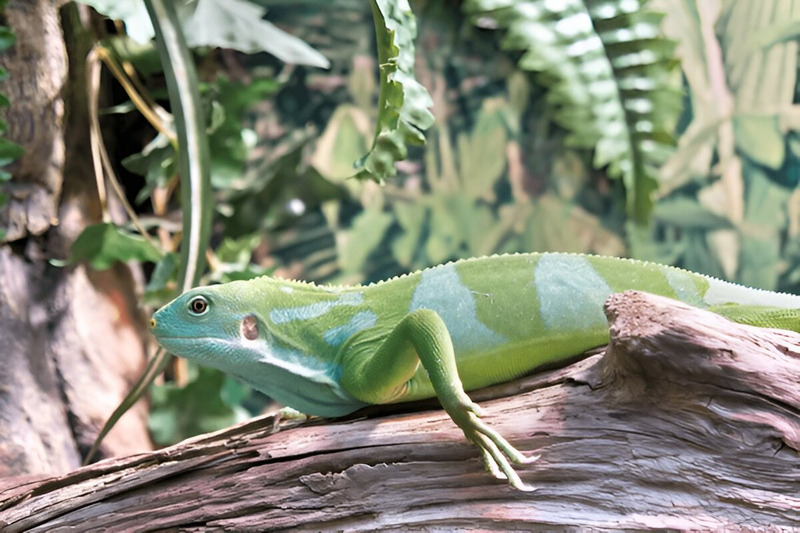
In the wild, these endangered lizards navigate through dense vegetation alone, their bright green and blue banded patterns providing perfect camouflage among the leaves. Scientists observe this solitary lifestyle across most Brachylophus fasciatus populations, noting rare exceptions only during mating periods.
This independence characterizes their ecological niche as specialized insectivores and folivores, allowing them to fulfill their role in South Pacific tropical forest ecosystems efficiently and without competition from their own kind.
How do Fiji banded iguanas communicate with each other?
Fiji banded iguanas communicate through body language and vocalizations.
Male iguanas perform head-bobbing displays and tongue flicking to attract mates. Females respond with subtle body movements and soft vocalizations. These behavioral signals establish both mating opportunities and social hierarchies within iguana populations.
These arboreal reptiles use display behaviors for daily social interactions. They signal dominance, submission, and territorial warnings through postural changes and specific movements. The communication system involves tail positioning, head gestures, and body orientation.
The visual signaling of Fiji banded iguanas (Brachylophus fasciatus) represents an evolved communication method adapted to their forest habitat. Their bright coloration enhances these signals, particularly during breeding season.
How do Fiji banded iguanas reproduce?
The Fiji Banded Iguana (Brachylophus fasciatus) reproduces by laying eggs, a reproductive process known as oviparity. Mating season begins in November during Fiji’s wet season. Males display courtship by intensifying their blue bands and performing head-bobbing rituals. Females signal readiness by approaching males. These reptiles mate in treetops through visual communication and physical contact.
After successful copulation, females deposit 3-6 eggs weighing about 0.7 oz (20 g) each in tree cavities or soil burrows. Females camouflage nests with leaves but provide no parental care afterward. Environmental stressors, such as the 2016 drought, can disrupt reproduction by limiting resources for egg development (Harlow & Hudson, 2014). Both sexes return to solitary living post-mating.
Incubation lasts 7-9 months, with hatchlings emerging around July-August. Newborns measure 6-7 inches (15-18 cm) and develop independently. Young iguanas grow 2-3 inches (5-7.5 cm) per year, reaching sexual maturity at 3-4 years old. Their life expectancy spans 10-15 years in natural habitats. Females typically produce clutches every two years.
Research by Harlow and Hudson (2014) indicates that habitat degradation threatens reproductive success, undermining the population stability of this endemic species.
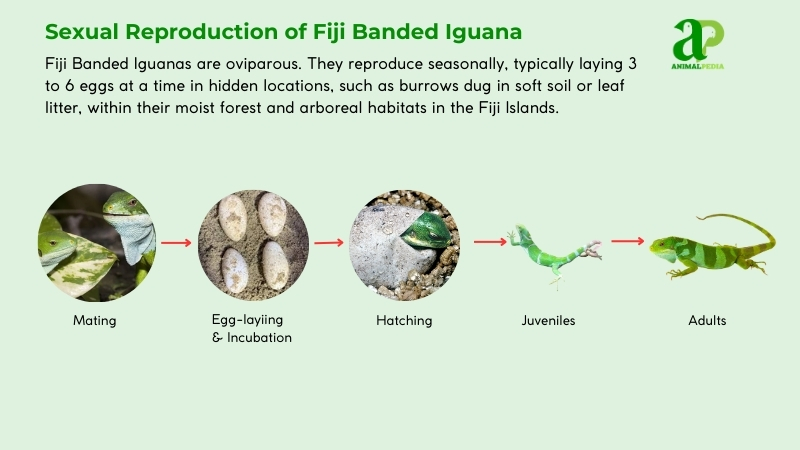
How long do Fiji banded iguanas live?
The Fiji Banded Iguana (Brachylophus fasciatus) has a life cycle of 10–15 years, from egg to death. Hatchlings mature in 3–4 years, with females laying eggs biannually. Habitat loss and climate change threaten longevity, per Morrison et al. (2017). The average lifespan in the wild is 12 years, with no significant difference between males and females—both typically reach 10–14 years under optimal conditions.
What are the threats or predators that Fiji banded iguanas face today?
Fiji Banded Iguanas (Brachylophus fasciatus) face five major threats pushing them toward extinction:
- Habitat destruction ravages their ecosystem. Deforestation for logging, agriculture, and fires has wiped out 50% of forest cover in just 40 years. This eliminates critical nesting sites and food sources, driving sharp population declines (Morrison et al., 2017).
- Invasive predators devastate these isolated island populations. This is a tragic theme for iguanas; the Galapagos Marine Iguanas faces similar extinction threats from introduced dogs and cats, while in Fiji, it is the Asian mongoose (Herpestes javanicus) and feral cats (Felis catus) that prey heavily on eggs and juveniles. Predation rates reach 70% on some islands, crippling population renewal.
- Climate disruption undermines breeding success. Rising temperatures and changing rainfall patterns disrupt reproductive cycles and food availability. Clutch success drops 20-30% during increasingly frequent drought years.
- Wildlife trafficking removes breeding adults from the wild. The illegal pet trade targets these iguanas for their distinctive banded patterns, with poachers removing an estimated 10-15% of adults annually from vulnerable populations.
- Native predators pose minimal threat. Indigenous hawks occasionally hunt adult iguanas, but represent a natural pressure the species evolved alongside.
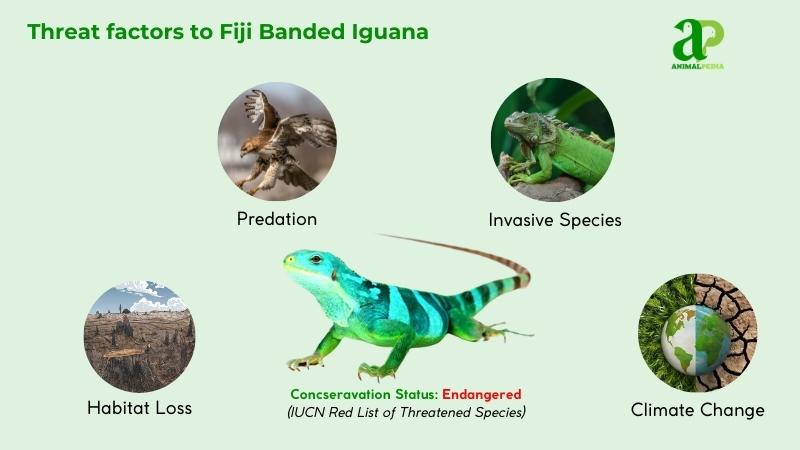
Human activity drives this decline. Agricultural expansion, mining operations, and settlement fragment critical forest habitat. Morrison et al. (2017) documented a 50% population collapse since the 1980s, attributing it directly to these anthropogenic pressures, compounded by weak conservation enforcement.
Are Fiji banded iguanas endangered?
The Fiji Banded Iguana is endangered. It faces serious survival threats in the wild. The International Union for Conservation of Nature (IUCN) classifies it as “Endangered”. This reflects its shrinking population across Fiji’s Lau Islands and introduced groups in Tonga and Vanuatu.
Population counts limited, but research shows alarming trends. Morrison et al. (2017) estimate that fewer than 10,000 mature iguanas exist today, with numbers having dropped by 50% since the 1980s. Their Pacific Science study found scattered populations, with no single group larger than 2,000 individuals. Habitat destruction and invasive predators worsen this decline.
Harlow & Hudson (2014) published in Herpetological Conservation and Biology estimated 8,000–12,000 wild iguanas total. They noted rapid population crashes on predator-inhabited islands like Viti Levu. Both research teams warn that continued forest clearing and predation could push this reptile species toward “Critically Endangered” status if current trends continue.
What conservation efforts are underway?
Conservation efforts for the Fiji Banded Iguana focus on habitat protection and controlling invasive species. The National Trust of Fiji (NTF) and San Diego Zoo Wildlife Alliance (SDZWA) lead these initiatives. Since 2009, NTF has conducted population surveys and restored habitats, notably on Monuriki Island, where they achieved Fiji’s first successful captive-bred release in 2015. SDZWA has managed the Species Survival Plan since the 1980s, maintaining the largest ex-situ population and supporting genetic research since 2010.
Legal frameworks protect these reptiles through Fiji’s Endangered and Protected Species Act (2002), which prohibits hunting, capture, and trade. This is reinforced by the CITES Appendix I listing since 1975, which bans international commercial trade.
Fiji’s Department of Environment enforces these regulations against violations like illegal wildlife trafficking, though challenges persist in implementation.

Frequently Asked Questions
How Do Fiji Banded Iguanas Communicate With Each Other?
To communicate, Fiji banded iguanas use various signals. Males stick out their tongues, flick them, and bob their heads rhythmically to attract mates. Females lay eggs after mating. This species’ reproductive process involves intricate behaviors and interactions.
What Is the Average Size of a Fiji Banded Iguana?
On average, a Fiji banded iguana can grow up to 2 feet long. They typically live for 10-15 years, but some in captivity have reached 25 years. These lizards prefer tropical wet islands at moderate elevations.
Do Fiji Banded Iguanas Have Any Predators in the Wild?
In their natural habitats, Fiji banded iguanas face limited predators. Due to their relatively large size, tough scales, and ability to blend in with their surroundings, these iguanas are not easy targets for predators in the wild.
Are Fiji Banded Iguanas Territorial Animals?
Yes, Fiji banded iguanas are territorial animals. They establish and defend their territories, showing aggression towards intruders. Males are especially territorial during mating season. Establishing boundaries helps them secure resources and attract mates effectively.
Do Fiji Banded Iguanas Hibernate During the Colder Months?
Yes, Fiji Banded Iguanas do not hibernate during colder months. They are active year-round, enjoying the tropical climate. So, you won’t find them snoozing through winter – they prefer to bask and explore!
Conclusion
Now you know all about the Fiji Banded Iguana! With their vibrant colors, unique adaptations, and solitary lifestyles, these amazing creatures are a fascinating part of the ecosystem in Fiji. By learning more about them, we can better understand the importance of protecting their habitats and ensuring their survival for future generations to enjoy. Keep exploring the world of reptiles and conservation, you never know what exciting discoveries await!





